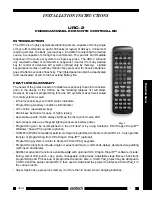
SARA-G3 and SARA-U2 series - System Integration Manual
UBX-13000995 - R26
Design-in
Page 128 of 217
2.5
SIM interface
2.5.1.1
Guidelines for SIM circuit design
Guidelines for SIM cards, SIM connectors and SIM chips selection
The ISO/IEC 7816, the ETSI TS 102 221 and the ETSI TS 102 671 specifications define the physical, electrical and
functional characteristics of Universal Integrated Circuit Cards (UICC) which contains the Subscriber Identification
Module (SIM) integrated circuit that securely stores all the information needed to identify and authenticate
subscribers over the cellular network.
Removable UICC / SIM card contacts mapping is defined by ISO/IEC 7816 and ETSI TS 102 221as follows:
Contact C1 = VCC (Supply)
It must be connected to
VSIM
Contact C2 = RST (Reset)
It must be connected to
SIM_RST
Contact C3 = CLK (Clock)
It must be connected to
SIM_CLK
Contact C4 = AUX1 (Auxiliary contact)
It must be left not connected
Contact C5 = GND (Ground)
It must be connected to
GND
Contact C6 = VPP (Programming supply)
It can be left not connected
Contact C7 = I/O (Data input/output)
It must be connected to
SIM_IO
Contact C8 = AUX2 (Auxiliary contact)
It must be left not connected
A removable SIM card can have 6 contacts (C1 = VCC, C2 = RST, C3 = CLK, C5 = GND, C6 = VPP, C7 = I/O) or
8 contacts, providing also the auxiliary contacts C4 = AUX1 and C8 = AUX2 for USB interfaces and other uses.
Only 5 contacts are required and must be connected to the module SIM card interface as described above, since
the modules do not support the additional auxiliary features (contacts C4 = AUX1 and C8 = AUX2).
Removable SIM card are suitable for applications where the SIM changing is required during the product lifetime.
A SIM card holder can have 6 or 8 positions if a mechanical card presence detector is not provided, or it can
have 6+2 or 8+2 positions if two additional pins related to the normally-open mechanical switch integrated in
the SIM connector for the mechanical card presence detection are provided: select a SIM connector providing
6+2 or 8+2 positions if the optional SIM detection feature is required by the custom application, otherwise a
connector without integrated mechanical presence switch can be selected.
Solderable UICC / SIM chip contacts mapping (M2M UICC Form Factor) is defined by ETSI TS 102 671 as follows:
Package Pin 8 = UICC Contact C1 = VCC (Supply)
It must be connected to
VSIM
Package Pin 7 = UICC Contact C2 = RST (Reset)
It must be connected to
SIM_RST
Package Pin 6 = UICC Contact C3 = CLK (Clock)
It must be connected to
SIM_CLK
Package Pin 5 = UICC Contact C4 = AUX1 (Auxiliary contact)
It must be left not connected
Package Pin 1 = UICC Contact C5 = GND (Ground)
It must be connected to
GND
Package Pin 2 = UICC Contact C6 = VPP (Programming supply)
It can be left not connected
Package Pin 3 = UICC Contact C7 = I/O (Data input/output)
It must be connected to
SIM_IO
Package Pin 4 = UICC Contact C8 = AUX2 (Auxiliary contact)
It must be left not connected
A solderable SIM chip has 8 contacts and can provide also the auxiliary contacts C4 = AUX1 and C8 = AUX2 for
USB interfaces and other uses, but only 5 contacts are required and must be connected to the module SIM card
interface as described above, since SARA-G3 and SARA-U2 modules do not support the additional auxiliary
features (contacts C4 = AUX1 and C8 = AUX2).
Solderable SIM chips are suitable for M2M applications where it is not required to change the SIM once installed.
















































